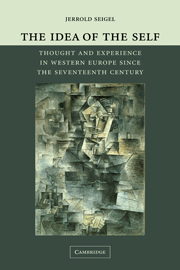Book contents
- Frontmatter
- Contents
- Acknowledgments
- PART I INTRODUCTORY
- PART II BRITISH MODERNITY
- PART III SOCIETY AND SELF-KNOWLEDGE: FRANCE FROM OLD REGIME TO RESTORATION
- PART IV THE WORLD AND THE SELF IN GERMAN IDEALISM
- 9 Autonomy, limitation, and the purposiveness of nature: Kant
- 10 Homology and Bildung: Herder, Humboldt, and Goethe
- 11 The ego and the world: Fichte, Novalis, and Schelling
- 12 Universal selfhood: Hegel
- PART V MODERN VISIONS AND ILLUSIONS
- Notes
- Index
10 - Homology and Bildung: Herder, Humboldt, and Goethe
Published online by Cambridge University Press: 05 June 2012
- Frontmatter
- Contents
- Acknowledgments
- PART I INTRODUCTORY
- PART II BRITISH MODERNITY
- PART III SOCIETY AND SELF-KNOWLEDGE: FRANCE FROM OLD REGIME TO RESTORATION
- PART IV THE WORLD AND THE SELF IN GERMAN IDEALISM
- 9 Autonomy, limitation, and the purposiveness of nature: Kant
- 10 Homology and Bildung: Herder, Humboldt, and Goethe
- 11 The ego and the world: Fichte, Novalis, and Schelling
- 12 Universal selfhood: Hegel
- PART V MODERN VISIONS AND ILLUSIONS
- Notes
- Index
Summary
When Kant introduced purposiveness into nature, he was in part replaying a move made by Leibniz, who also attributed a teleological structure to the world in order to preserve the integrity of rational beings against the threat posed by scientific determinism. If monads followed their own internal principles, then their actions and destinies were not the products of external, mechanical causes. But Kant asked more from purposiveness than his predecessor had, making it not just the guarantee of individual integrity and unity, but the ground on which the noumenal self could come together with the empirical one, so that finite, material human beings might realize the moral freedom toward which their rationality pointed. Leibniz's monads were free from external control, since all their actions developed out of their own inner principle of existence; but this kind of freedom had a passive side, because each monad's doings were in some way predetermined by its principle, and this in turn was rooted in the mind of God. The contrast suggests that to envision an isomorphism between self and world could lead to greater or lesser claims about the powers of the self.
Both alternatives were alive among Kant's contemporaries and successors in Germany. Some of his followers were in search of ways to provide fuller or more radical validation for human freedom by giving reflective self-consciousness power over the material world. We will come to them shortly.
- Type
- Chapter
- Information
- The Idea of the SelfThought and Experience in Western Europe since the Seventeenth Century, pp. 332 - 360Publisher: Cambridge University PressPrint publication year: 2005

